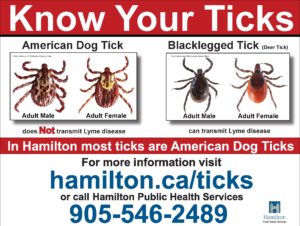Just the thought of ticks can give the heebie jeebies, but don’t let that deter you from enjoying time outside. With that said, it is still important to be smart about ticks and the risk they pose.
What You Need to Know About Ticks
Ticks are bugs that live in wooded areas, tall grasses and bushes and attached to human or animals as they pass by. They are primarily found in spring and summer, but climate change is extending tick season and it is not uncommon to see them as early as March and even into the fall.
 Types of Ticks
Types of Ticks
There are two types of ticks found in the Hamilton area, the American Dog tick and Blacklegged tick. The City of Hamilton Pubic Health Services notes that at this time, the most predominant type of tick found in Hamilton is the American Dog tick which does not transmit Lyme disease.
American Dog Tick
Also known as Wood tick, are the most common ticks in the Hamilton area. Dog ticks do not carry the bacteria that causes Lyme disease.
How to identify: Dog ticks have white marking on its back, and an unfed adult is about 4-6 mm in length.
Blacklegged Ticks
Formerly called Deer tick, Blacklegged ticks may carry the bacteria that causes Lyme disease, which is spread through a bite. It is possible that Blacklegged ticks may be found in Hamilton.
How to identify: Blacklegged ticks have dark brown markings on its back and an unfed adult is about 3-5mm in length.
Tick Bite Prevention
Your best defense from getting Lyme disease is to prevent tick bites altogether. There are a few things you’ll want to do before and after heading out to protect yourself.
Before heading out…
- Wear light-coloured clothing outdoors – it makes ticks easier to spot.
- Wear long pants and a long-sleeved shirt.
- Wear socks and close toe shoes.
- Tuck your pants into your socks.
- Use a tick repellent that contains DEET or lcaridin and follow the manufacturer’s directions for application. Apply the repellent to your skin and outer clothing, but avoid your eyes and mouth, as well as cuts and scrapes.
- Avoid areas known to be infested with ticks when possible.
After you’ve been out…
- Check yourself, children and pets thoroughly for ticks. Be sure to check:
- Behind your knees
- Your head and hair
- Belly button
- Groin area
- Armpits
- Your back – with help from someone else or a mirror
- Check for ticks again after a few hours.
- Have a shower when you get home, which can wash off any ticks and also makes it easier to do thorough inspection.
- Put your clothes in the dryer on a high heat for 10 minutes to kill any ticks.
What if you find an attached tick?
- Use fine-tipped tweezers, carefully grasp the tick as close to your skin as possible. Pull it straight out, gently but firmly. DO NOT squeeze the tick
- Do not put anything on the tick, or try to burn the tick off.
- Thoroughly clean the bite site with rubbing alcohol and/or soap and water.
Additional Resources on Ticks & Lyme Disease
City of Hamilton Public Health Information Page
Province of Ontario Information Page





